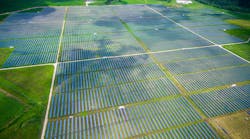California has a solar and wind problem. At times during the year when the state’s electrical demand is low (as in the spring), weather-governed solar and wind power may be operating at near-peak levels. If this mismatch between electrical demand and supply is large enough, the California Independent System Operator (CAISO) may curtail solar and/or wind production.
In 2014, around 36 GWh of renewable energy was curtailed because of market conditions, constraints and stability reasons. This is an obvious problem for the owners of renewable energy generation, but it is also worries those concerned about atmospheric CO2 levels. Why? Because a unit of renewable electricity not produced represents a lost opportunity to replace an equivalent amount of electricity produced with fossil fuels.
As California continues to add solar and wind, these and other operational problems will only grow. According to a 2015 California Public Utilities Commission (CPUC) staff white paper, the state “is unlikely to cost-effectively integrate the renewables necessary to reach a 50% renewable target, without further transformation of the electric grid.”
So, what is needed? The CAISO and others want to expand the grid in order to export excess California renewable energy to grids in other Western states. On the surface, it makes perfect sense. If a region produces an abundance of any valuable product, the opportunity exists to export that excess to other regions.
This is what California’s leading consumer of solar energy does. No, it’s not Intel, Google or Apple. The solar energy consumer I am speaking of is California agriculture. Blessed with ample sunlight and favorable growing conditions, this $50 billion a year enterprise ships its abundance to other states and to countries around the world. So, why not do the same with excess California “grown” sun power?
As with any big idea, there are potentially many obstacles. Expansion of the transmission grid is not a trivial undertaking. The infrastructure can be expensive, regulatory and environmental requirements can be daunting, and proposed transmission routes are rarely, if ever, enthusiastically embraced by the public. There is also the matter of getting multiple government entities, system operators, utilities and other stakeholders to agree to the best way forward. Lastly, let’s not forget about the always-challenging task of determining who is going to pay how much for what.
The aforementioned obstacles, though formidable, can be overcome, particularly if there is the political will to do so. However, there is a bit of a problem with California selling its excess solar power to others. The problem is that not all of California’s excess solar power is priced to sell — at least not to buyers who have choices.
With California’s net metering tariff (recently extended by the CPUC to 2019), consumers with rooftop solar sell their surplus solar energy (what is not used locally) back to their utility at the prevailing retail rate, regardless of wholesale market conditions.
On a blistering hot summer day when demand for power is high and generation resources are scarce, these customers get paid for surplus power at the same price that other retail customers pay for their power. On a cloudless but mild spring day when demand is low, generators are offline and wholesale electric prices are tanking, they still get the same price for their surplus. As the percentage of solar on the grid grows, it is on the low-demand days that California should have the most solar power available to sell and that represents a market opportunity — if the price is right.
Power markets are complex and simple examples can quickly break down. Real-time market prices are affected by multiple considerations. However, I find it difficult to imagine a scenario that would have wholesale buyers in other states clamoring to buy California solar power at prices equal to or greater than California residential retail electric rates that, in most cases, exceed their own retail rates. Few market entities survive long with the mantra “buy-high, sell-low.”
If California is successful in creating a regional power market in the West, will it be selling the cheaper utility-scale solar power to out-of-state customers while requiring California customer to purchase the more expensive consumer-made solar power? If that were to happen at any significant scale, it could make for some very interesting future headlines.
For solar to become an increasingly larger part of our energy mix, changes are needed. An expanded grid is needed to move excess solar power to favorable market locations. Electric storage is needed to “move” it to a more favorable market times. Additionally, willing customers are needed to “move” their electric usage to times of excess solar production. These changes will be made only if the difference between the buying price and selling price is great enough to support such moves.
With a variable cost close to zero, solar is ideally suited to generate large revenues when the power prices are high and still make out when prices are low. I think solar power will prove to be a highly resilient market participant. Let’s allow it to compete.


